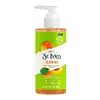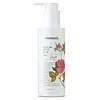What's inside
What's inside
 Key Ingredients
Key Ingredients

 Benefits
Benefits

 Concerns
Concerns

 Ingredients Side-by-side
Ingredients Side-by-side

Water
Skin ConditioningCocamidopropyl Betaine
CleansingDipropylene Glycol
HumectantHydroxypropyl Methylcellulose
Emulsion StabilisingPanthenol
Skin ConditioningSodium Chloride
MaskingC12-14 Pareth-12
EmulsifyingPhenoxyethanol
PreservativeDisodium EDTA
Ethylhexylglycerin
Skin ConditioningTocopheryl Acetate
AntioxidantPropanediol
SolventPrunus Armeniaca Fruit Extract
Skin ConditioningCI 17200
Cosmetic ColorantCI 19140
Cosmetic ColorantParfum
MaskingLinalool
PerfumingLimonene
PerfumingBenzyl Salicylate
PerfumingHexyl Cinnamal
PerfumingGeraniol
PerfumingWater, Cocamidopropyl Betaine, Dipropylene Glycol, Hydroxypropyl Methylcellulose, Panthenol, Sodium Chloride, C12-14 Pareth-12, Phenoxyethanol, Disodium EDTA, Ethylhexylglycerin, Tocopheryl Acetate, Propanediol, Prunus Armeniaca Fruit Extract, CI 17200, CI 19140, Parfum, Linalool, Limonene, Benzyl Salicylate, Hexyl Cinnamal, Geraniol
Water
Skin ConditioningCyclopentasiloxane
EmollientCocos Nucifera Oil
MaskingHexylene Glycol
EmulsifyingCoco-Caprylate/Caprate
EmollientSodium Chloride
MaskingLauryl Methyl Gluceth-10 Hydroxypropyldimonium Chloride
Phenoxyethanol
PreservativePotassium Phosphate
BufferingCaprylyl/Capryl Glucoside
CleansingDisodium EDTA
Ethylhexylglycerin
Skin ConditioningDipotassium Phosphate
BufferingPropanediol
SolventButylene Glycol
HumectantNelumbo Nucifera Flower Extract
Skin ConditioningNelumbo Nucifera Germ Extract
Skin ConditioningTocopherol
Antioxidant1,2-Hexanediol
Skin ConditioningWater, Cyclopentasiloxane, Cocos Nucifera Oil, Hexylene Glycol, Coco-Caprylate/Caprate, Sodium Chloride, Lauryl Methyl Gluceth-10 Hydroxypropyldimonium Chloride, Phenoxyethanol, Potassium Phosphate, Caprylyl/Capryl Glucoside, Disodium EDTA, Ethylhexylglycerin, Dipotassium Phosphate, Propanediol, Butylene Glycol, Nelumbo Nucifera Flower Extract, Nelumbo Nucifera Germ Extract, Tocopherol, 1,2-Hexanediol
Ingredients Explained
These ingredients are found in both products.
Ingredients higher up in an ingredient list are typically present in a larger amount.
Disodium EDTA plays a role in making products more stable by aiding other preservatives.
It is a chelating agent, meaning it neutralizes metal ions that may be found in a product.
Disodium EDTA is a salt of edetic acid and is found to be safe in cosmetic ingredients.
Learn more about Disodium EDTAEthylhexylglycerin (we can't pronounce this either) is commonly used as a preservative and skin softener. It is derived from glyceryl.
You might see Ethylhexylglycerin often paired with other preservatives such as phenoxyethanol. Ethylhexylglycerin has been found to increase the effectiveness of these other preservatives.
Phenoxyethanol is a preservative that has germicide, antimicrobial, and aromatic properties. Studies show that phenoxyethanol can prevent microbial growth. By itself, it has a scent that is similar to that of a rose.
It's often used in formulations along with Caprylyl Glycol to preserve the shelf life of products.
Propanediol is an all-star ingredient. It softens, hydrates, and smooths the skin.
It’s often used to:
Propanediol is not likely to cause sensitivity and considered safe to use. It is derived from corn or petroleum with a clear color and no scent.
Learn more about PropanediolChances are, you eat sodium chloride every day. Sodium Chloride is also known as table salt.
This ingredient has many purposes in skincare: thickener, emulsifier, and exfoliator.
You'll most likely find this ingredient in cleansers where it is used to create a gel-like texture. As an emulsifier, it also prevents ingredients from separating.
There is much debate on whether this ingredient is comedogenic. The short answer - comedogenic ratings don't tell the whole story. Learn more about comegodenic ratings here.
The concensus about this ingredient causing acne seems to be divided. Research is needed to understand if this ingredient does cause acne.
Scrubs may use salt as the primary exfoliating ingredient.
Learn more about Sodium ChlorideWater. It's the most common cosmetic ingredient of all. You'll usually see it at the top of ingredient lists, meaning that it makes up the largest part of the product.
So why is it so popular? Water most often acts as a solvent - this means that it helps dissolve other ingredients into the formulation.
You'll also recognize water as that liquid we all need to stay alive. If you see this, drink a glass of water. Stay hydrated!
Learn more about Water